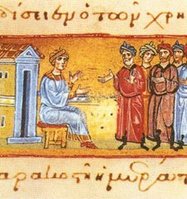 Now that i have your attention lets look to what the many various sources say about Barlaam and Josaphat, including the Catholic Encyclopedia. Right out the gates The Columbia Encyclopedia, Sixth Edition. 2001-05 states :
Now that i have your attention lets look to what the many various sources say about Barlaam and Josaphat, including the Catholic Encyclopedia. Right out the gates The Columbia Encyclopedia, Sixth Edition. 2001-05 states :"Barlaam and Josaphat, a legend popular in medieval times. It corresponds in part to the legend of Buddha. Versions of the story have been found in nearly every language." The Columbia Encyclopedia
The Getty Museum, which holds a german manuscript (Barlaam und Josaphat), compiled by Rudolf von Ems in the 1200s, states :
The text of Barlaam and Josaphat is a Christianized version of the story of Siddhartha (later known as the Buddha). According to the revision, the young Indian prince grew up sheltered from the world in a luxurious palace and was devastated when he encountered death and illness for the first time. A Christian monk by the name of Barlaam heard of his distress and introduced Josaphat to Christianity. Much to the chagrin of his father, King Avenir, Josaphat adopted Christianity as his faith. Instead of succeeding his father as king, Josaphat decided to spend the rest of his days in the desert with Barlaam, leading the life of a hermit. Upon their deaths, both Barlaam and Josaphat were recognized as saints. The GettyThe Catholic Encyclopedia States :
The story is a Christianized version of one of the legends of Buddha, as evenA Bodhisattva is one who seeks enlightenment so that, once awakened, he may efficiently aid other beings with the expertise of supreme wisdom. Gautama Buddha, the historical buddha and founder of Buddhism, was a bodhisattva not only in his life, but as recorded in his previous incarnations.
the name Josaphat would seem to show. This is said to be a corruption of the
original Joasaph, which is again corrupted from the middle Persian Budasif
(Budsaif=Bodhisattva). The Catholic Encyclopedia
Wikipedia explains the change in language from the term Bodhisattva to Josaphat best :
Josaphat’s name may be traced to the Sanskrit term bodhisattva via the MiddleHowever, Barlaam nor Josaphat where offically formally canonized, they were included in earlier editions of the Roman Martyrology (feast day 27 November). Nonetheless, the tale was popular among the many during the Middle Ages, who saw Josaphat as a Saint. Not to mention that with-in the The Golden Legend, Josaphat is seen as the successor to Saint John Damascene. Bear in mind that The Church only began to formalized canonization in the 13th century, when it was discovered that many 'Saints' where indeed A) from other faiths, as in this regard or B) nonexistent individuals based soley on Legend. This is why before formal canonization, Gautama Buddha was a Christian Saint.
Persian bodasif. Investigation by researchers at the Korean Seoul National
University indicates that the name Buddha or Bodhisatta in Sanskrit changed
to Bodisav in Persian texts in the sixth or seventh century, then to
Budhasaf or Yudasaf in an eighth-century Arabic document, and Iodasaph in
Georgia in the 10th century. That name was then adapted to Ioasaph in Greece in
the 11th century, and Iosaphat or Josaphat in Latin since then." Wiki
You can read The Golden Legend Here at the Catholic Saints Forum : The Golden Legend




2 comments:
Give me a piece of scripture or religious text that has stood the trials of time. Give me something that human kind hasnt fucked with or thought in some egotistical way they could improve on something not meant to be altered. You show that too me and I will slap it out of your hand and call you a liar! And point to your face and then put my hands on my hips and give you this really cold look..I'm not talking like ice cold just "You disqust me" coldness.
I discovered this legend about 10 years ago when reading an old edition of Butler's Lives Of The Saints. When I showed this to people at the Catholic Church I attended, and most of them scoffed. To me, it simply proves that many of the world's faiths are more similar than different and it's politics and the desires of people to have hegemonic power that makes the basic message of love and peace get lost in translation. Thank you for sharing this interesting bit of theology and history.
Post a Comment